
Catarina or Catharina Ykens or Catarina Ykens (II) [1] (1659 - 1737 or later) was a Flemish painter. The few surviving paintings attributed to her are still lifes but she is also believed to have painted history paintings with biblical themes. [2]

Catarina or Catharina Ykens or Catarina Ykens (II) [1] (1659 - 1737 or later) was a Flemish painter. The few surviving paintings attributed to her are still lifes but she is also believed to have painted history paintings with biblical themes. [2]
She was born in Antwerp as the daughter of the painter Johannes Ykens and his second wife Barbara Brekevelt and was baptized on 24 February 1659. She was the sister of Peter Ykens, a history and portrait painter. [2] She apprenticed under her father and became a master in the Antwerp Guild of Saint Luke in the guild year 1687-1688. [3] [4]
The record of the Guild mentions that she was a geestelycke dochter (spiritual daughter), a term which refers to an unmarried Catholic woman who took a vow of chastity before a priest, usually obeying, not bound by vows, a superior, also known as her confessor. [5]
It is not clear when she died. A Nativity in Aix-en-Provence is signed and dated 1737. This is her latest known dated work. [2]
She is known for her flower garland paintings, vanitas still lifes as well as history paintings with biblical themes. [2] [6] The few surviving paintings attributed to her are still lifes. Her works are sometimes confused with the works of another Antwerp painter of the same name known as Catarina Ykens (I) (née Floquet), born between 1608 and 1618 in Antwerp, who was the wife of the still life painter Frans Ykens. [7] [8]

She painted garland paintings. Garland paintings are a special type of still life developed in Antwerp by Jan Brueghel the Elder in collaboration with the Italian cardinal Federico Borromeo at the beginning of the 17th century. Other artists involved in the early development of the genre included Hendrick van Balen, Andries Daniels, Peter Paul Rubens and Daniel Seghers. The genre was initially connected to the visual imagery of the Catholic Counter-Reformation movement. [9] It was further inspired by the cult of veneration and devotion to Mary prevalent at the Habsburg court (then the rulers over the Habsburg Netherlands) and in Antwerp generally. [9] [10]
Garland paintings typically show a flower garland around a devotional image, portrait or other religious symbol (such as the host). [10] By the second half of the 17th century secular themes such as portraits and mythological subjects also decorated the central part of the many paintings made in this fashion. Two examples of such later development are two signed garland paintings by Catarina Ykens in the Museo del Prado, Madrid: the Flower garland with landscape and the Landscape inside a garland. These works are usually attributed to Catarina (II) but may also have been painted by Catarina (I). [8] The two compositions depict a garland of flowers and leaves surrounding a landscape. In each of these works, the landscape was not painted by Catherine Ykens herself, but the identity of their author(s) is not known. [11]

She is also known for a vanitas still life, a genre of still life which offers a reflection on the meaninglessness of earthly life and the transient nature of all earthly goods and pursuits. This meaning is conveyed in these still lifes through the use of stock symbols, which reference the transience of things and, in particular, the futility of earthly wealth: a skull, soap bubbles, candles, empty glasses, wilting flowers, insects, smoke, watches, mirrors, books, hourglasses and musical instruments, various expensive or exclusive objects such as jewellery and rare shells. The term vanitas is derived from the famous line 'Vanitas, Vanitas. Et omnia Vanitas', in the book of the Ecclesiastes in the bible, which in the King James Version is translated as "Vanity of vanities, all is vanity". [12] [13]
The worldview behind vanitas paintings was a Christian understanding of the world as a temporary place of fleeting pleasures and sorrows from which mankind could only escape through the sacrifice and resurrection of Christ. A wheat stalk symbolises, for instance, the resurrection of Christ on which, according to the Christian faith, the salvation of each human being depends. While most of these symbols reference earthly existence (books, scientific instruments, etc.) or the transience of life and death (skulls, soap bubbles) some symbols used in the vanitas paintings carry a dual meaning: the rose refers as much to the brevity of life as it is a symbol of the resurrection of Christ and thus eternal life. [14] Catarina's composition Vanitas bust of a lady with a crown of flowers on a ledge (signed and dated on the ledge: Catharina van ÿkens . filia Devota f. 1688, at Sotheby's London of 6 July 2017, lot 115) contains the typical symbols present in vanitas paintings such as a skull and wilting flowers, but has a distinctive macabre aspect by putting the skull crowned with a wig on a bust and having a bird pick at some berries on a branch pinned to the front of the bust. [15]

Nicolaes van Verendael or Nicolaes van Veerendael was a Flemish painter active in Antwerp who is mainly known for his flower paintings and vanitas still lifes. He was a frequent collaborator of other Antwerp artists to whose compositions he added the still life elements. He also painted a number of singeries, i.e., scenes with monkeys dressed and acting as humans.
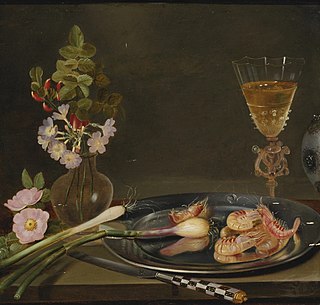
Frans Ykens was a Flemish still life painter active in Antwerp and Brussels in the 17th century. He is mainly known for his flower pieces and fruit still lifes and also painted banquet pieces, pronkstillevens, garland paintings and larger game pieces.

Cornelis Norbertus Gijsbrechts or Gysbrechts was a Flemish painter who was active in the Spanish Netherlands, Germany, Denmark and Sweden in the second half of the seventeenth century. He was a court painter to the Danish royal family. He specialised in trompe-l'œil still lifes, an artistic genre which uses visual tricks to give viewers the illusion that they are not looking at a painting but rather at real three-dimensional objects. He also created many vanitas still lifes.

Hendrick Andriessen, known as Mancken Heyn was a Flemish still-life painter. He is known for his vanitas still lifes, which are made up of objects referencing the precariousness of life, and 'smoker' still lifes, which depict smoking utensils. The artist worked in Antwerp and likely also in the Dutch Republic.
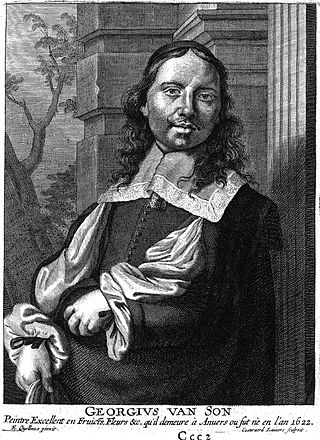
Joris van Son or Georg van Son was a Flemish still life painter who worked in a number of sub-genres but is principally known for his still lifes of fruit. He also painted flowers, banquets, vanitas still lifes and pronkstillevens. He is known to have painted fish still lifes representing the Four Elements, and also collaborated with figure artists on 'garland paintings', which typically represent a devotional image framed by a fruit or flower garland.

Cornelis van der Meulen or Cornelis Vermeulen, was a Dutch painter who after training in the Dutch Republic had a career in Sweden where he became a court painter. He is known for still lifes of flowers and game, trompe-l'œil and vanitas still lifes, topographical views and portraits.

Carstian Luyckx, also known as the Monogrammist KL, was a Flemish painter and draughtsman who specialized in still lifes in various subgenres including flower still lifes, fruit still lifes, fish still lifes, pronkstillevens, vanitas still lifes, hunting pieces and garland paintings. He also painted animals and a few genre scenes. After starting his career in Antwerp he is believed to have worked later in France.

Jan Pauwel Gillemans the Elder was a Flemish goldsmith and still life painter who is known for his fruit still lifes, flower pieces, vanitas still lifes and pronkstillevens.

Franciscus Gijsbrechts, was a Flemish painter of still lifes specialised in vanitas still lifes and trompe-l'œil paintings. He worked in the second half of the seventeenth century in the Spanish Netherlands, Denmark and the Dutch Republic. Like his father, he painted trompe-l'œil still lifes, a still life genre that uses illusionistic means to create the appearance that the painted, two-dimensional composition is actually a three-dimensional, real object.
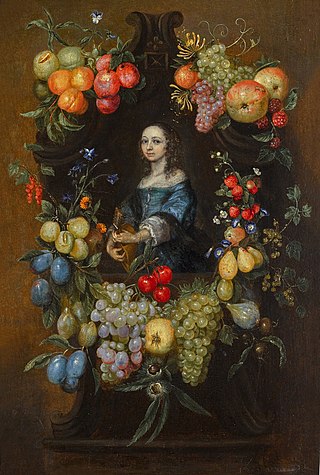
Catarina Ykens or Catarina Ykens (I) (née Floquet) (1608/1618 – after 1666) was a Flemish still life painter. She is known for flower and fruit garland paintings and vanitas paintings.

Peter Willebeeck or Petrus Willebeeck was a Flemish still life painter who was active in Antwerp in the second quarter of the 17th century. He is known for his fruit still lifes, vanitas still lifes, pronkstillevens and banquet pieces executed in a very delicate manner.

Frans van Everbroeck was a Flemish still life painter who is known for his fruit still lifes, vanitas still lifes and pronkstillevens. He was active in Antwerp, Amsterdam and London. The Dutch painters Abraham Mignon and Maria van Oosterwyck are regarded as his followers.
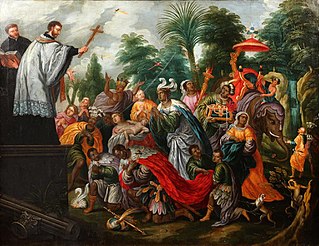
Peeter Sion or Peter Sion was a Flemish painter of landscapes, history paintings and genre scenes. His work was mainly produced for the export market and dealt with biblical stories.
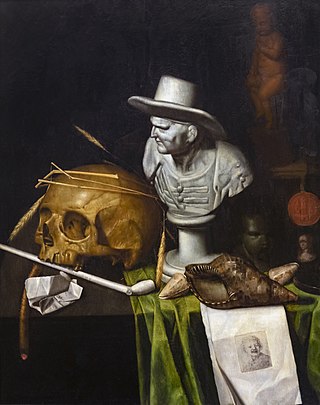
Joannes de Cordua or Johann de Cordua was a Flemish painter who was mainly active in Vienna and Prague. He is known for his still lifes, peasant scenes, portraits, and biblical themes.
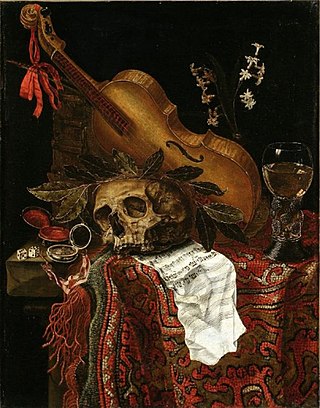
Peter van Kessel or Peeter van Kessel was a Flemish still life painter who worked in a number of sub-genres but is principally known for his flower pieces, game pieces, garland paintings and vanitas paintings. He trained in Antwerp but mainly worked abroad, and in particular in Northern Europe.

Godfriedt van Bochoutt was a Flemish still painter who was active in his native Bruges and Rotterdam. The limited body of work attributed to him ranges from fruit still lifes, hunting still lifes, vanitas still lifes and trompe l'oeil paintings.

Carel Fonteyn or Carel Fontyn was a Flemish painter active in Antwerp. He is known for his Vanitas still lifes with flowers, skulls and other Vanitas symbols.
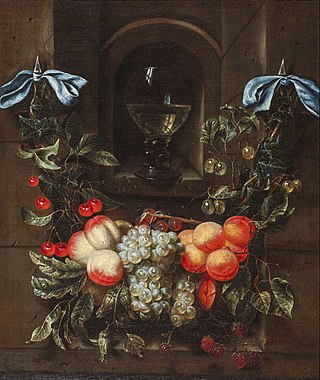
Maria Tassaert was a Flemish still life painter active in Antwerp. She had a short career during which she painted garland paintings, a type of still life painting comprising a garland of flowers around a devotional or other image. She was a member of the Tassaert family of artists, which was active in the Habsburg Netherlands, France, Prussia and England in the 17th and 18th centuries.

Pseudo-Roestraten or Pseudo-Roestraeten is the notname given to an artist or artists to whom or which are attributed a number of vanitas still lifes likely created in the period between 1675 and 1725. The notname was given as the artist's works show some resemblance to that of the Dutch painter Pieter Gerritsz van Roestraten. Recurring elements of the paintings are arrangements of books, documents and precious objects with a vanitas meaning displayed on oriental carpets. The artist(s) may have been of German or Scandinavian origin. Many works of the anonymous artist are or were held in English collections, which makes it likely that the artist worked for some time in England.

Christian von Thum or Christian von Thum (I) (Kalmar, c. 1625 – Stockholm, 12 August 1686) was a Swedish innkeeper, still life painter, decorative painter, set painter, copyist and art agent. His known works include vanitas still lifes and still lifes with foodstuffs, paintings of hermits and religious paintings.